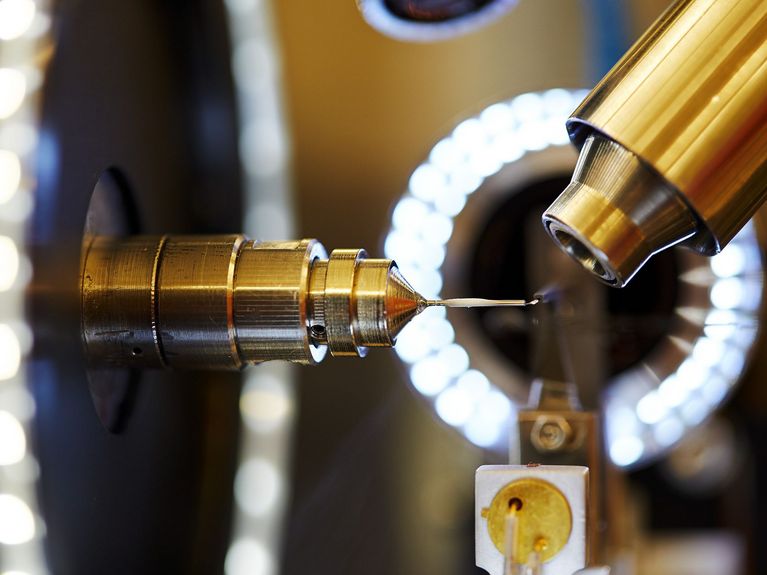5 Questions for Edgar Weckert
X-ray vision for the future

Bio-imaging and diffraction beamline at PETRAIII is dedicated to imaging and diffraction experiments of biological samples. Picture: DESY / Heiner Müller-Elsner
In this interview, Weckert discusses various aspects of his work, including the impact of extremely high-luminosity X-ray radiation and the possibilities for analyzing sustainable materials for the future.
Edgar Weckert, Head of the Photon Science division at the German Electron Synchrotron DESY, conducts research on PETRA III, one of the highest-luminosity storage ring X-ray sources in the world. As one of the most powerful light sources of its kind, PETRA III offers scientists outstanding possibilities for conducting experiments with X-ray radiation. These particularly conducive conditions benefit experts who want to examine small samples using microscopes and need tightly collimated, very high-intensity X-ray light for their analyses. In this interview, Weckert discusses various aspects of his work, including the impact of extremely high-luminosity X-ray radiation and the possibilities for analyzing sustainable materials for the future.
The importance of X-rays is common knowledge. But what’s so special about the accelerator-based X-rays produced by a synchrotron radiation source like PETRA III—a 2.3-kilometer-long circular accelerator for generating X-ray light?
The radiation from a synchrotron like PETRA III is extremely luminous. Another way of describing this is that the light has extremely low divergence, or is collimated. The conditions for the scattering experiments can be specified very precisely; the synchrotron radiation provides extremely high resolutions of the sample structures being analyzed as well as their energy states. In addition, the synchrotron radiation is more intense by many orders of magnitude than the X-ray light from conventional X-ray tubes. PETRA III also offers the option of “tuning” the wavelengths, so to speak, which gives us an almost unlimited capacity to customize the color of the light. This makes our spectroscopy particularly sensitive in terms of distinguishing between the elements in the samples we examine. We can also adjust the polarization of the light, which means the direction of oscillation of the X-ray light can be aligned in a defined orientation. This makes it possible to analyze magnetic samples on the microscale. All of these possibilities create significant advantages for us when analyzing our experiments.
DESY is planning an upgrade for its synchrotron. What capabilities is PETRA IV designed to have that PETRA III doesn’t have yet?
So far, the X-ray imaging of the samples we have analyzed using PETRA III has delivered almost exclusively static images. Moreover, we can only see a sample’s electron density at the highest resolution. The PETRA IV X-ray, on the other hand, will have a luminosity that is up to three magnitudes greater. The beam will be more coherent, which is to say it will be more consistent. This creates the conditions for significantly more efficient focusing and will also help us to capture the dynamics inside the sample while simultaneously enabling extremely high spatial resolution in the nanometer range.
What challenges does PETRA IV present in terms of the technical aspects of the project as well as from a physical and management perspective?
From a technical perspective, we are dealing with the highest requirements as regards the machine’s stability and reliability, and this is actually a factor at every level—from the storage ring, to the beam guides, to the experiment stations, including when it comes to the stability required of the experiments, detectors, and data management. In physical terms, PETRA IV involves extremely demanding beam dynamics so it can achieve the goals that have been set for it. But the related measuring procedures with X-ray optics and detection schemes on the user side are also very demanding. Our aim is to run measurements with a higher level of automation, which requires an expedient approach for standardizing the experiments and analysis tools. And the technical and logical elements of implementing a project like this are equally demanding: This is a large-scale project in the truest sense of the word that needs to be implemented in an existing laboratory environment in the shortest time possible—according to a pre-defined schedule and budget.
An accelerator-based light source involves a combination of different disciplines—you have accelerator physics on the one side, and on the other you have a very wide range of uses ranging from medicine, to structural biology, and all the way to quantum physics. How can you coordinate scientific topic areas like these? How are the corresponding groups of researchers organized?
We held various workshops with everyone involved in order to put together our plan for a PETRA IV facility. This included users on the one side, and machine physicists on the other. And in between them we had the researchers from the field of photon science, who are very familiar with both sides. Based on this approach, we worked to optimally reflect the requirements of the user group in the beam parameters. The beam parameters were then discussed with the storage ring experts appointed to design and build the facility.
What key scientific achievements could PETRA IV lay the groundwork for in the future?
PETRA IV could give us fundamental insights into physicochemical and functional biological processes of life and its mechanisms—from the molecular details and their interactions, to the cells, to the organs and the brain. PETRA IV has the potential to play a significant role in helping us to finally understand how they are all linked together as a whole. But PETRA IV will also create the conditions for breakthroughs in materials research, for example in the field of structural and process analyses in the area of the so-called nanoscale, for example on batteries and their catalytic reactions, photovoltaics, and chip technology. Put simply, PETRA IV will be dedicated to the analysis of sustainable materials for the future. And that’s why we also call PETRA IV “the highest-resolution X-ray process microscope of the future.”
Readers comments